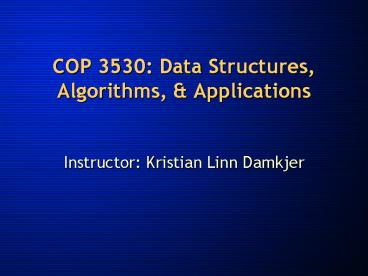COP 3530: Data Structures, Algorithms, PowerPoint PPT Presentation
1 / 22
Title: COP 3530: Data Structures, Algorithms,
1
COP 3530 Data Structures, Algorithms,
Applications
- Instructor Kristian Linn Damkjer
2
Course Overview
- Syllabus Review
3
What The Course Is About
- Applications are developed to solve real-world
problems. - All programs manipulate data.
- Programs must represent data in some way.
- Data structures focuses on data representation
and manipulation. - Data manipulation requires algorithms.
- Algorithms are the fundamental elements in
application development.
4
Prerequisites
- Java
- CIS 3020 or CIS 3022 CIS 3023
- You should be proficient and self-sufficient
- You must be capable of writing programs without
the aid of a compiler.
5
Prerequisites
- Asymptotic Complexity
- COT 3100
- We will use primarily O notation.
- f(n) O(g(n)) Big Oh notation
- f(n) is bounded above by g(n)
- You should also be comfortable with T and O.
- f(n) T(g(n)) Big Theta notation
- f(n) is asymptotically equivalent to g(n)
- f(n) O(g(n)) Big Omega notation
- f(n) is bounded below by g(n)
6
Prerequisites
- Strong Mathematical Reasoning
- Any of the various flavors of Calculus 2.
- At the very least you need to understand
- Sequences
- Series
- Summations
- Integration
- Differentiation
- Matrices
- Vectors
7
Web Sites
- http//www.cise.ufl.edu/kdamkjer/courses/su05/cop
3530/ - Announcements
- Syllabus
- Handouts
- Exercise Solutions
- Assignments
- TAs and Discussions
- http//www.cise.ufl.edu/sahni/cop3530/
- Text
- Source Codes
- Past Exams
- Past Exam Solutions
8
Assignments
- Assignment guidelines
- Submission procedures
- Do Assignment 0 by Friday!
9
Source Codes
- Read download and use instructions.
- Read download and use instructions.
- Must have Java 1.2 or higher
- Hopefully you have 1.4.2 or 1.5.0 (5.0)
- Review the source code documentation
- ProgramIndex.html
- AllNames.html
- Other HTML files produced by Javadoc
10
Discussion Sections
- Go to either one
- TAs will answer your questions on lectures and
assignments. - TAs will cover exercises from the text.
- Web site lists topics and exercises for each
discussion section.
11
Textbook
- Its not rocket science (really)
- Its computer science
- There are three sections to the textbook
- Background (Chapters 1-4)
- Data Structures (Chapters 5-17)
- Algorithms (Chapters 18-22)
- What about Applications?
- Well cover applications throughout the entire
semester along with general theory and other
concepts.
12
Grades
- Assignments 25
- Five Graded Projects
- No drops permitted
- Each worth 5
- Exams 75
- Three Exams
- No drops permitted
- Each worth 25
13
Grades
- Historic Cutoffs
- A 83
- B 75
- B 70
- C 65
- C 60
- D 55
- D 50
14
Classic Problem
- Sorting
15
Classic Problem Sorting
- Given a list of comparable elements
- a0, a1, ,an-1
- Rearrange the list into a specific order
- Typically increasing or decreasing order.
16
Classic Problem Sorting
- Given a list of comparable elements
- a0, a1, ,an-1
- Rearrange the list into a specific order
- Typically increasing or decreasing order.
- Objective
- a0 a1 an-1
- Examples
- 8, 6, 9, 4, 3 ? 3, 4, 6, 8, 9
- 8, 3, 6, 2, 8, 10, 2 ? 2, 2, 3, 6, 8, 8, 10
17
Sorting Methods
- Insertion
- Bubble
- Selection
- Count
- Shaker
- Shell
- Heap
- Merge
- Quick
18
Sorting Methods
- Insertion
- Bubble
- Selection
- Count
- Shaker
- Shell
- Heap
- Merge
- Quick
19
Inserting an Element
- Given a sorted list (sequence), insert a new
element - Given 3, 6, 9, 14
- Insert 5
- Result 3, 5, 6, 9, 14
20
Inserting an Element
- Insert 5 into the list 3, 6, 9, 14
- Compare new element (5) and last element in list
(14) - Shift 14 right to get 3, 6, 9, , 14
- Shift 9 right to get 3, 6, , 9, 14
- Shift 6 right to get 3, , 6, 9, 14
- Insert 5 to get 3, 5, 6, 9, 14
21
Inserting an Element
- // insert t into a0i-1
- int j
- for (j i 1 j gt 0 t lt aj j--)
- aj 1 aj
- aj 1 t
22
Next Time in COP 3530
- Read Chapters 14 for review of topics covered
today - Performance Analysis and Measurement
- We will start the Data Structures portion of this
course - Start thinking about different ways to represent
data - Read Chapter 5.15.2
- Data Structure Linear Lists

